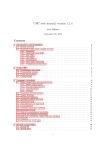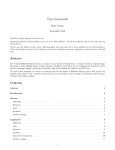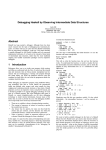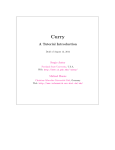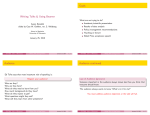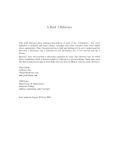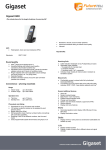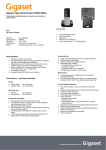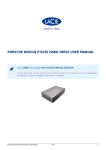Download Handout 11
Transcript
Reminder!
Class Wednesday will be held in Berger Auditorium, where Yaron
Minsky will be talking about the use of functional languages at
Jane Street Capital.
CIS552: Advanced Programming
Handout 11
Graduation!
You’re now familiar with pretty much all of the basic concepts in
Haskell.
Haskell Miscellany
There is more to learn, of course, but from now on I’m mostly going
to let you figure things out as you need to know them.
A Few More Topics We’ll Cover Together
• Module system
• today
• Concurrency
• after spring break
Other Features to Investigate Yourselves
• Exception handling
• raise exceptions anywhere
• handle them in the IO monad
• Advanced type class features
• multi-parameter type classes, functional dependencies, etc.
• Many useful libraries
• Etc.
Haskell Resources
• The Haskell 98 report
• The Haskell Hierarchical Libraries documentation
• The GHC User’s Manual
Modularity
All are easy to find on-line.
It would be a good idea to skim these documents now, just so you
have a sense of what’s there in case you need it later.
Abstraction
The Evils of Duplication
Every time something is duplicated in your program, you’ve got a
bug waiting to happen.
A great deal of duplication involves things that are almost but not
quite the same.
Abstraction is the antidote to this kind of duplication.
Principle: Every piece of knowledge should have a single, authoritative representation within a software system.
Principle: When things start to get duplicated, look for a way of
separating (“abstracting out”) the common part from the varying
parts.
In their book, The Pragmatic Programmer, Hunt and Thomas talk
about the DRY principle: Do not Repeat Yourself!
Conceptually, the common part becomes a function and the
varying parts become parameters that are supplied to the function
to yield particular instances.
Often, the abstracted-out common part will turn out to be
interesting in itself and to have other potential uses.
Generality
The temptation to duplicate often arises from trying to program
against insufficiently general abstractions.
Principle: When building an abstraction, try to find a “natural”
level of generality that leaves room for applications besides the
one you’ve got in mind right now.
Dangers of Abstraction and Generality
Warning: Although more abstraction is generally a good thing,
there are limits!
• Choosing to abstract instead of duplicate often comes with a
cost in terms of the complexity / readability of the code.
• Similarly, a more general abstraction is sometimes harder to
understand than a more specific one.
Principle: Use taste when deciding how much to abstract.
It’s OK to duplicate something that is really never going to change,
or where the “knowledge” being duplicated is very simple.
Example
DRY documentation
Duplication occurs not only between different bits of code, but
between code and documentation!
Which is better?
ex1 =
do putStrLn ("The user’s last name is " ++ lastname)
putStrLn ("The user’s first name is " ++ firstname)
ex1’ =
do aux "last name" lastname
aux "first name" firstname
where aux x y =
putStrLn ("The user’s " ++ x ++ " is " ++ y)
Principle: Code should be self-documenting whenever possible.
For example:
• A meaningful variable name is better than an obscure name
with a meaningful comment.
• Breaking up a complex function into several bite-sized pieces
is better than writing a long explanation of how it works.
• Unnecessary documentation is worse than none at all.
In general, use comments only to explain high-level features of
code. Low-level details should usually be clear from the code itself.
Locality of Repetition
Checked Documentation
• Type declarations are a good idea because they are checked
documentation: they are useful to readers, but if they get out
of date with respect to the code, the compiler will complain.
Principle: When something must be repeated, the two copies
should be located as close as possible to each other — preferably immediately adjacent.
• Ditto assertions.
• Ditto unit tests.
Principle: Documentation should be checked whenever possible.
For example, the documentation of a program’s switches and
preferences (for the user manual) should live in the code, near
where the switches themselves are defined and used.
(Example from Unison.)
Components
Complex software systems need to be organized into bite-sized (or
brain-sized) chunks, of manageable size and complexity.
Loose Coupling
Two components are orthogonal if one can be changed without
affecting (or even knowing about!) the other.
This is also known as loose coupling.
These chunks are generally called components or modules.
Loose coupling is the quality that keeps large systems “light on
their feet” — maintainable, extensible, and resilient to change.
Interfaces
Cohesion
Another important way of increasing orthogonality is limiting the
“surface area” that each module presents to the others in a system.
The flip side of loose coupling is ensuring that individual
components have clearly defined roles.
Principle: Each component of a system should have a single,
well-defined purpose.
The interface of a component limits which parts of its internals are
exported for the use of other components.
Abstract Data Types
An abstract data type (or ADT) is a component that provides a
single (usually) type and a collection of associated operations.
The type is “abstract” in the sense that the component’s interface
exposes only the name of the type, not its concrete definition. The
only way other modules can do things with values of this type are
via the operations exported by the defining component.
The Haskell Module System
(Note the similarity to the notion of class in OO languages.)
Modules
A Haskell program is a collection of modules, one of which, by
convention, must be called Main and must export the value main.
The value of the program is the value of the identifier main in
module Main, which must be a computation of type IO t for some
type t. When the program is executed, the computation main is
performed, and its result (of type t) is discarded.
Modules may reference other modules via explicit import
declarations, each giving the name of a module to be imported and
specifying its entities to be imported. Modules may be mutually
recursive.
Module Names
The name-space for modules themselves is flat, with each module
being associated with a unique module name (which are Haskell
identifiers beginning with a capital letter). There is one
distinguished module, Prelude, which is imported into all modules
by default.
Hierarchical Modules
Module names are allowed to contain the character “.” — e.g.,
Data.Time.Calendar.Easter is a valid module name.
Module syntax
(See 5.1 in Haskell 98 Report.)
Implementations may (and GHC does) choose to interpret dots in
module names as instructions for where to look for modules in the
file system during compilation.
E.g., the module Data.Time.Calendar.Easter might be found in a
directory Data with a subdirectory Time containing a
sub-sub-directory Calendar containing a file Easter.hs.
Export lists
(See 5.2 in Haskell 98 Report.)
Import Declarations
(See 5.3 in Haskell 98 Report.)
Abstract Data Types
A nice convention for using ADTs (originally from CLU?) is always
to call the main type of the module just T.
module Stack( StkType, push, pop, empty ) where
module Stack ( T, push, pop, empty ) where
data StkType a = EmptyStk | Stk a (StkType a)
push x s = Stk x s
pop (Stk _ s) = s
empty = EmptyStk
data T a = EmptyStk | Stk a (T a)
push x s = Stk x s
pop (Stk _ s) = s
empty = EmptyStk
The “.T” Convention
Now, if other modules import the Stack module with the qualified
keyword, the name of the abstract type becomes Stack.T — nice!
The “.T” Convention
To keep programs from getting unreasonably verbose when using
this style, the names of modules need to be kept fairly short. So, if
Stack were actually called Mystuff.Util.Data.Stack, we would
rename it locally using as:
module M where
import qualified Stack
...
import qualified Mystuff.Util.Data.Stack as Stack
...
myStack :: Stack.T Int
myStack = Stack.pop (Stack.push 5 Stack.empty)
Interfaces
Summmary
Haskell’s module system is rather basic, as functional languages
go. (For example, OCaml, Standard ML, and PLT Scheme all offer
much more sophisticated features.)
Every Haskell module has an interface, in the sense of a set of
facilities (types, values, and classes) that it makes available to the
rest of the world.
However, it can be used together with some programming
conventions to get the job done in a great many situations.
However, there is no particular place where its interface is
specified.
• The names that it exports are listed in the exports clause at
the top.
• But the types of these names are not.
For example...
In other words, to know how to use a module, we need to look at its
implementation — bad!
Most module systems provide a separate syntactic construct
(which often even lives in a separate file) for writing down
interfaces, so that users of a module are not even tempted to look
at its internals — indeed, they may not be given the source code
for its internals, and the internals may not even be written yet.
Interfaces
This situation is not ideal for modular programming, but there are a
variety of ways to work with it.
Two common ones:
• Provide interfaces “by convention”
• Extract interfaces from implementations
Interfaces by Convention
Haskell doesn’t provide any way to put a module’s interface in a
separate file. But it can at least be collected in a separate part of
the file.
module Stack ( T, push, pop, empty ) where
-- type T a
empty :: T a
push :: a -> T a -> T a
pop
:: T a -> T a
------------------------------------------------ Implementation:
data T a = EmptyStk | Stk a (T a)
push x s = Stk x s
pop (Stk _ s) = s
empty = EmptyStk
Extracting Interfaces
Another point of view is to leave the type declarations adjacent to
their definitions (which avoids editing two parts of the file when
things change) and instead using a tool to extract the interface
from the module.
Indeed, we can go a step further, keeping not only the type
signature but also the documentation for interface functions.
(Haddock demo.)







